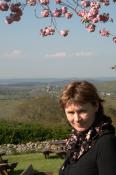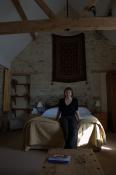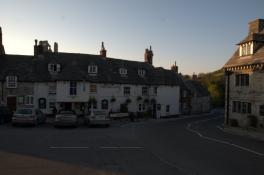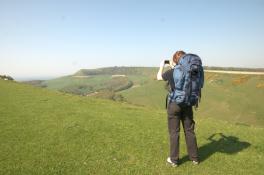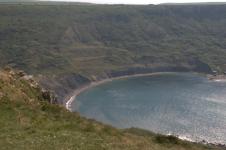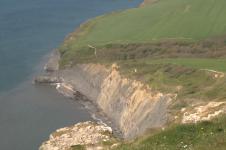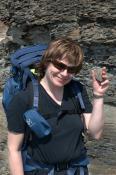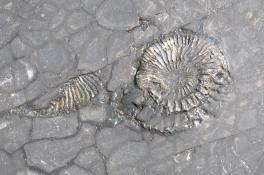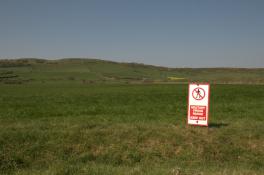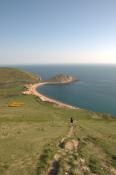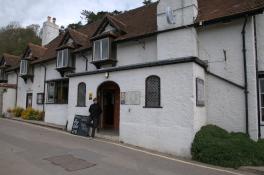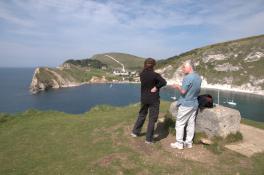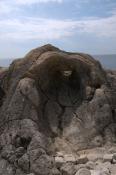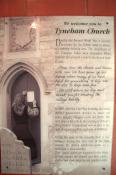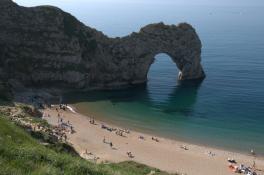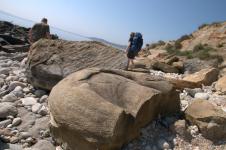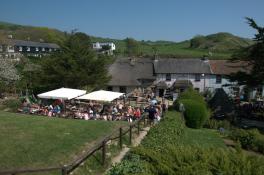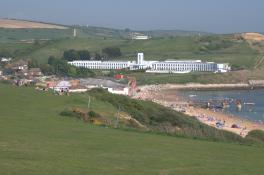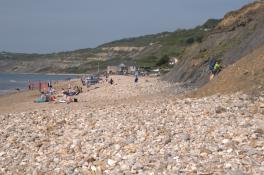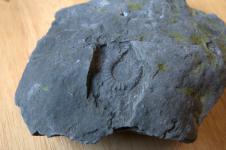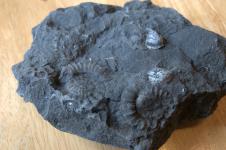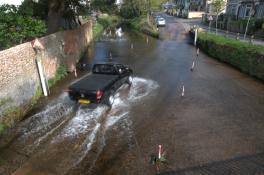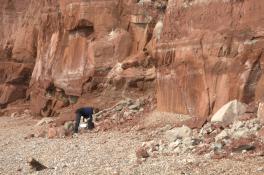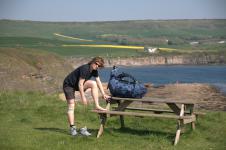Walking Without Dinosaurs
After joining a seminary about the Jurassic Coast, my Scientist Factory wife, Hanne, wanted to go fossil hunting. And she wanted me to follow. Fossils are great, but as my wife knows me quite well, she realized that fossils alone may not qualify for walking many miles a day, so she added some English pubs to the equation, and I was in.
Since we didn't know anything about the southern coast of England, Hanne arranged with Robert Westwood, local geologist, photographer, author and enthusiast of Jurassic Coast Walking, to plan everything for us. We gave him some money, and he made sure everywhere we stayed were reserved and paid upfront. We got maps and every detail, all we had to do was to find out how to get to England and back again. And we're quite familiar with that. Teaming up with Robert was a wise decision, since we got everything we wanted (except dinosaur fossils (hard to find); hence the title).
So we packed our 45l backpacks with everything we needed, and then some: Laptops (using it right now for typing this), Nikon D300s (see included photos), boots (didn't need those), rain dress (didn't need that either), warm sweaters (somewhat useful), underwear (needed, I think), power outlet adapters (desperately needed), various chargers, toothbrush and similar stuff (yes, needed when you travel with someone), and long jeans (not needed (extraordinarily good weather, they say)). For a total of about 13 kg/29 lbs. And then we took off, an early morning from Oslo, to get there. Hunting fossils and tasting beer. This is our diary.
Day one: Getting there
| From | Oslo |
|---|---|
| To | Kingston |
| Transport | Plane, bus |
| Staying at | Kingston Country Courtyard |
| Weather | Sunny, approx. 20C/68F |
For some reason, my wife always books the early planes, so we got up at five in the morning. That made us reach Gatwick/London far earlier than we actually had to, so we decided to spend some time at our favorite London pub, the (British) Museum Tavern. Unfortunately, it was closed at those early hours, so instead we spent a couple of hours in London's electronic street, the Tottenham Court Road, looking for laptop screen protection mats for my friends who kindly lent me theirs for this trip. With no luck either. I'll have to wash it and return it, I think.
Oh, well. After a lunch and a few ales in London, we got to the Waterloo train station, and spent two hours on a train to get to Wareham in Dorset. Then we got on the number 40 bus, and after about 20 minutes we reached Kingston, after passing the tremendous Corfe Castle, which we visited later in the evening.
The one and only pub in Kingston is the Scott Arms. They serve great ales, and from the backyard you have a marvelous view of the Corfe Castle. Unfortunately, the kitchen was closed due to repairs of the stove, so we didn't get to taste any of the local cooking. We had a couple of beers, though.
Walking along the road from Scott Arms for about five minutes brought us to Kingston Country Courtyard (KCC), where we had booked a room for the night. And what a room! High ceiling, old stone walls, in what appeared to be an old barn. No Internet connection in the room, though; we had to be in the dining hall for that.
Shortly after arriving at KCC, Robert Westwood, our guide, knocked on the door to give as some maps and the final details for our walk. For the next day we could either take a bus to Swanage and walk from there, or we could shave off about 10 km/6 mi by starting the walk directly from Kingston. Unsure about our walking capabilities, we selected the second option. And we did not regret that decision later. After promising to meet us again in two days, Robert left.
Since KCC didn't serve dinner, only breakfast, we had the staff at Scott Arms order a taxi to get us to Corfe Village, where we had dinner at the Greyhound Inn. Corfe appeared as a sleepy village with lots of small stone houses. I suspect many of them were built using stones from the castle, which was blown up on purpose in 1646.
Unfortunately, the castle was closed for the day, so we only got to see it from the outside. We spent some time walking around in the village before returning to our room for the night. We had arranged with the friendly taxi driver to pick us up at 9 o'clock, and he showed up right on time. Due to time zone confusion we, on the other hand, showed up an hour early. It took some time before we realized our mistake, but luckily we had time for another ale at the Greyhound while waiting.
Day two: Pushing it
| From | Kingston |
|---|---|
| To | West Lulworth |
| Transport | Feet (25.7 km/16.0 mi) |
| Staying at | The Beach House |
| Weather | Sunny, approx. 20C/68F |
After having a good night's sleep for once, we woke up and had a nice English breakfast at the Kingston Country Courtyard. (In fact we ended up having English breakfast every day, in the belief that it would provide long lasting energy for our walks.)
So we packed our bags, brushed our caps, walked out into the world.
Past the Scott Arms (too early for beer (ie. closed)), past the Kingston St. James Church, and onto a forest path. After about half an hour under the trees, the landscape opened up to reveal the beautiful sight we would get quite familiar with the next few days: A magnificent, wide open, green and quite Shire-like landscape, complete with sheep and plenty of what they naturally leave behind. And did I mention that it was warm, and that the sun was shining?
Upon reaching the edge of the cliff, we first turned east because we wanted to see Chapman's Pool, as it supposedly is rich on fossils. But we realized the we would have to go quite a distance to get there, and that we would have to climb all the way back up again, so we saved it for a future trip.
Instead we started walking westwards. Along the water line there were white cliffs with green hills as far as the eye could see. And just at the edge of every cliff, a white footpath that we should follow for many miles.
Our next destination was Kimmeridge Bay, with another beach famous for its abundance of fossils. Supposedly, we should also be able to find the only pub along the route nearby. With Hanne's hunger for fossils, and my thirst for beer, we started walking at quite some pace, singing and cheering. It felt just right; these bodies were made for walking.
When reaching Kimmeridge Bay we were both hungry and thirsty, so the fossils would have to wait. Walking about a kilometer inland on a small asphalt road, we reached the tiny Kimmeridge village. After presenting a dry-mouthed "where's the pub" to a local, we were pointed in direction of Clavell's Cafe & Farm Shop. Here we had a wonderful lunch accompanied by a couple of Old Speckled Hen ales.
Returning to the bay, we realized that these bodies weren't made for walking on asphalt. But the sore feet were quickly forgotten once we started looking at all the stones on the beach. One would have to be blind to miss the fossils. Small stones contained small fossils, and the old sea floor layers had larger ammonites embedded in them. Ammonites were squid-like creatures with a spiral shell. Naturally, the shells are all that remains.
When I realized that Hanne was about to start turning every stone on the beach for the second time, I figured it was time to move on. Hanne followed reluctantly.
Right after the beach we passed an oil pump on what is said to be the oldest oil well in England still in production. We giggled a bit about the lousy 80 barrels a day, but doing the math with today's oil prices, we realized that having such a pump wouldn't be that bad.
Right after the pump, we entered a military firing range. This range was actually so big that the rest of the day was spent walking inside it. It was littered with signs stating that we should not stray from the marked path, or else we could die from unexploded shells. For some reason, those unexploded shells didn't stop an army of cows from grassing over the entire area. But although cows might be immune to explosives, we are not, so we stuck to the path. Even though some potential short cuts were rather tempting at times.
With about half of the day's route behind us, we started to realize that we were out of walking practice. At least with backpacks. The singing and chanting were long gone, and it didn't help much that the (still) beautiful landscape changed from "on top of the ridge" to "down and up and down and up". A couple of hills were actually quite steep. And although they were nothing compared to the Norwegian mountains, they were not very welcome after a long day of walking. But we kept the mood up the best we could: At least the sun was shining. At least the ground was dry and not slippery. And we had wonderful company. At the end of the day we laughed about it and felt quite proud of ourselves. This was good; this we should do more.
After almost stepping on an adder, spotting wild deer and three New Forest ponies, we finally reached West Lulworth. We were happy to find that the place we were staying at was the shortest walk after entering the village.
The Beach House looked cozy on the outside, but what can I say? When you find the leftovers of the previous guest's hard work floating in the toilet, the suspicion rises. The dinner didn't help much either. If we ever go to West Lulworth again, we will pick another accommodation.
Fun fact: When entering The Beach House, you will notice a sign on the door stating: "We're famous. Look us up on Google Maps." Only problem is that even thought they state that they have wireless Internet on the premises, you will have to sit at a particular table in the restaurant, facing Mecca, to have it working. You can look them up using the (flawless) wireless connection in the neighboring hotel, though. The food is much better there too, and they serve ales by the tap. Bottles only at The Beach House.
Off to bed, after applying lotion to our feet. The next day we would rest and just explore the local area, guided by Robert Westwood.
Day three: Resting
| From | West Lulworth |
|---|---|
| To | West Lulworth |
| Transport | Feet , car |
| Staying at | The Beach House (one more night) |
| Weather | Mostly sunny, approx. 20C/64F |
After another English breakfast, and a visit to one of the local stores to refill our 50+ sun block, Robert Westwood showed up to take us on a tour of the area.
First we climbed to the ridge east of the cove, and found an amazing fossilized forest. There were no standing tree trunks, but we saw some fallen trunks, and quite a few stumps. What we saw, called stromatolites, were not actually fossilized trees, but rather fossilized algae that had encapsulated the trees when they, for some reason, were submerged into water. We spent quite some time in this fascinating landscape.
Afterward, Robert brought us to another nice pub, the Weld Arms, where we had lunch in the large outdoor area. Then he took us on a visit to Tyneham Village. Although not from the distant past, this small, deserted village has an intriguing history. In preparation for the D-day during World War II, the British army needed somewhere to practice landing, and chose Tyneham. The inhabitants were told to move out and promised that they could return after the war.
One thing really touched me in Tyneham: The note left on the door of St. Mary's church by the last people to abandon the village. It read:
But they never got to return. After WW II the army still needed an area for practice, this time in preparation for the Cold War.
Enough sentimentality. After Tyneham, Robert brought us back to West Lulworth, and we said goodbye to this fine gentleman for the last time.
For the rest of the day, nothing special happened. We had dinner and Internet access at the aforementioned neighboring hotel, and then we went to sleep. More walking would follow.
Day four: Still going strong
| From | West Lulworth |
|---|---|
| To | Weymouth |
| Transport | Feet (21.4 km/13.3 mi) |
| Staying at | B+B Weymouth |
| Weather | Sunny, approx. 22C/72F |
Not long after we started our route west of Lulworth, we got into wondering whether we were still in England, or if we were in fact somewhere near the Mediterranean Sea. There were beaches looking just as inviting as those in Greece. One of them, with the famous Durdle Door arch, could even have been in Thailand (although I've never been there, I've seen the James Bond movie).
None of the sun-bathers appeared to be water-bathing, so I guess the water temperature wasn't quite there yet. We didn't try. But we did walk: After one day of hard practice and one day of rest, we felt ready for everything.
On our quest for beers, we were told that we could have two stops on our route from Lulworth to Weymouth to lubricate our tongues. One in Ringstead Bay, and one in Osmington Mills. That showed up to be not quite right. Although Ringstead had a nice place for campers, sausages and everything, they did not serve any beer. Luckily, Osmington Mills, with the famous Smuggler's Inn, was not far away, so we walked even faster from Ringstead than we did before.
Osmington Mills. In our hurry to reach the pub, we first had to pass the beach. Here we noticed a lot of what we thought was strange, large, round fossils, but which afterward proved to be Oolites. Just look it up, I don't even know how to explain it. Further on to the pub for lunch.
At the Smuggler's Inn we were not disappointed, to say the least. The pub provided the best Burger since whenever, and they also served a nice ale called Tanglefoot. The name, according to legend, comes from a naming contest in which, after having too much of it, one of the participants had his feet tangled, and fell to his knees. True or not, the ale was delicious. But we couldn't afford having our feet tangle, since we still had quite a distance to go along the cliff edges, so we just had a couple of those.
Moving on, it became apparent that we were approaching civilization again. The beaches were increasingly packed with people. On the outskirts of Weymouth we went past the huge Riviera Hotel, which for some reason was closed behind tall fences. We got that Mediterranean feeling again. This was a part of England we had never seen before.
According to the papers from our guide, we should head into Weymouth and find B+B near the beach. B+B sounded quite like Bed & Breakfast, the cheapest kind, but we were surprised to realize that this was in fact the nicest "hotel" (according to our liking) of all the places we stayed. Newly renovated, a very supportive Spanish host, clean and neat. And the Internet connection worked flawlessly. B+B wasn't easy to find, though. Among all hotels with big, glaring signs, this one just had a small plate beside the door. We walked past it several times before spotting it.
B+B was B&B after all; just breakfast, so we went out for Italian pizzas before returning to bed, knowing that the rest of the trip would be rather easy going compared to the last few days.
Day five: Off piste
| From | Weymouth |
|---|---|
| To | Sidmouth |
| Transport | Taxi, feet (16 km/10 mi) |
| Staying at | Westcliff Hotel |
| Weather | Mostly sunny, approx. 18C/64F |
This day had several options for when to walk and when to catch a bus, but we didn't follow any of them. We hooked up with a taxi, and followed in the footsteps of Mary Anning (1799-1847). Our first stop was at the beach off Charmouth. And here I have to warn anyone following in our footsteps: We spent more than an hour walking back and forth on the beach without finding any fossil at all, even though this beach is supposed to be a fossil hunter's paradise. Only afterward did we visit the Heritage Coast Center, in which we learned how to actually look for fossils. So if you ever go there, visit the Heritage Center first, then go to the beach.
Next stop: Lyme Regis. Due to a land slide the coastal path was closed, so we had to walk along the roads for several kilometers. Asphalt is (as we knew by now) quite straining on the feet, so we didn't want to walk much more this day after reaching Lyme. But we did anyway; back and forth, and back again on the beaches on both sides of town. And it really payed off, at least on the west side; the Monmouth beach. Traces of Ammonites everywhere, including a layer that appeared as an ammonite graveyard, with literally hundreds of ammonites within hundreds of square meters. Amazing!
And like a grand finale, just before leaving, Hanne spotted a cracked rock. When peeling away one of the corners, she found a small ammonite. Then she cracked the rest of the rock open, and there were several more. These creatures hadn't seen the sun for more than 100 million years, and no one had seen them since then either. But Hanne freed them. A great moment for both of us, and well worth the entire trip!
Totally forgetting about time, lunch was long overdue. But we had lunch anyway, at the Pilot Boat Inn. Here we also picked a "taxi card". There are no London-like cabs in this area. If you want to go from one town to another, you have to choose between a plethora of "long distance car" companies that typically leave their cards at the pubs. We called one of those, and found that it was in fact a two-man business. But we had to wait for an hour, because "Arsenal is playing". Charming. And plenty of time for another beer at the Pilot Boat.
We told the driver (who was a bit upset that Arsenal had failed him today) to take us to Westcliff Hotel in Sidmouth, upon which we learned that "Westcliff is a posh hotel! Very posh!". I'm quite certain he didn't figure how we would fit in there with our dirty shorts, sweaty T-shirts and bulky rucksacks.
When entering the hotel, we had doubts ourselves. But after ordering both the bottom line wine for dinner and Champagne afterward, we were accepted. A posh hotel indeed.
Day six: And back again
| From | Sidmouth |
|---|---|
| To | Oslo |
| Transport | Train, plane |
| Staying at | Home |
| Weather | Sunny, approx. 18C/64F |
Our small adventure was coming to an end. The plane didn't leave until 20:00, so we had plenty of time to explore on the final day as well. We originally planned on going early to London in order to spend the day there. But we decided that we have seen London quite a few times, and never seen Sidmouth, so we stayed for a while.
The seam of my shorts was broken, so we went into a Surf Shop to get a new one. Once there, I noticed that my sunglasses were falling apart as well, so I bought a new couple of glasses too. This trip ended up being the first in history in which I did the shopping, and my wife did no shopping at all. Probably because her small sack was already full.
Sidmouth had this strange road which passed a canal. Doesn't sound that strange perhaps, but this road was actually built into the canal. Complete with gates that closed when the water was running too high, and bars displaying the water level. I've never seen this kind of construction before, and doubt I will ever see it again.
We had a couple at the Anchor Inn, and then went off to the beach. Again. This beach differed from all the other beaches we had seen, as the cliffs were red and sand-like. We had stepped into the remains of the Triassic period. Except for the beautiful color, we didn't find anything. Perhaps due to our still untrained eyes.
It was time to go home. First by train to London, then by plane to Norway. Quite shocked, we found that even the British railways seem to do the same mistake as they do back home: Forget about the holiday rush seasons. We had to literally stand on the train for exactly three hours. But after all the walking, we had plenty of exercise, so we managed.
Now, sitting snugly in my favorite chair at home, with a glass of my favorite wine at hand, jotting down my final thoughts, the standing on the train, the sore feet, the toilet submarine and the lack of Internet connectivity don't matter at all. This was a journey to remember.
Thanks, Hanne! And thanks, Robert.
The hindsight
We didn't experience any real problems on our fantastic journey. But this is what we wish we had known in advance:
- There are no shops in Kingston, our starting point. The extremely good weather surprised us, and the tiny bottle of sun block we brought from Norway proved too tiny. We got burnt.
- We ran out of water once, even though we brought 1.4 liters with us every day. We walked for pretty long distances without seeing a single house, or better; a pub, and given the baking sun and the climbing, perspiration dried us up quickly, with no means of refilling the bottles.
- We brought two boxes of Compeed blister plaster with us. And we used them both, mainly because Hanne had new mountain boots for this trip.
- Cell phone GPS uses a lot of power. In combination with the weak or non-existing mobile signals, battery power was drained quickly. I used Google's "My Tracks" to track our movement, and was saved by stealing pub electricity a couple of times. After realizing that switching to airplane mode would get rid of one of the sources for the drain, things went much better.
But to sum it up: We regret that this adventure didn't last even longer. Now we're just looking for the next opportunity for a similar experience.
